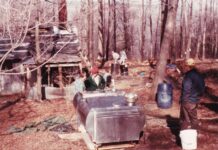On the second day of the 2018 Farm Science Review, I was trying to prepare myself for the experience of a tractor rollover simulator — recalling the different times when I knew someone who had rolled a tractor, and trying to remember some of the first-hand experiences I had with tractor safety as a boy.
My editor had asked me to try my hand at the rollover simulator, and to write a first-person story for our readers. As it turned out, however, this year’s simulator was actually on fall protection. We had misread the press release — but realizing the equal danger that falling can be for our farmers — I decided to put on the virtual-reality equipment and participate in the fall-protection simulation.

Before I tell you about the simulator, let me tell you a little about my own experience with falling. Like most people who grew up on a farm, I had my share of slips and mishaps with ladders and standing on things I probably shouldn’t have — but my biggest mistake was my sophomore year of college, when I was helping to paint a horse barn roof, and I fell through a skylight.
Another man and I were power washing the roof in preparation for the paint, and I was pulling the power washer hose up onto the central part of the roof, because it kept falling over the edge. In my mind, the biggest danger was staying away from the edge, so I thought that since I was in the center, I was safe. What I forgot, however, were those darned skylights — in this case, flat sheets of sun-bleached fiberglass — not strong enough to hold a bucket of paint — let-alone a 165-pound man.
I was walking backward as I pulled the hose, walking closer and closer to the center of the roof, when I stepped and fell through a skylight, and in an instant, I was falling, weightlessly, to what I thought surely would be my death. I felt a thud much sooner than I knew I should have — the thud of a wooden floor and some dusty hay chaff. I had landed on the flat part of a loft, and not on the concrete bottom that I had expected. I ended up with a concussion and a very good/bad scare.
That memory was with me as I put on the simulator equipment at the Farm Science Review — a computerized set of goggles and some hand-held controls. The computer simulator put me atop a two-story commercial building, where my job was to oversee the installation of a security camera near the edge of the roof — where a fall risk was clearly present. But my job was to identify all of the fall risks, which included two skylights and an open hole. Both of the skylights had a raised frame, and were not flush to the roof, like the one I fell through, but they were still considered fall hazards.

I also had to review different types of fall-protection harnesses and I had to identify possible anchor points to anchor the lanyards that were attached to the worker’s harness.
It wasn’t just enough to have the man in a harness and attached to a cable and anchor — I had to consider whether the harness was in good working order, whether the man was wearing it correctly and whether the anchor was truly strong enough to hold the man, plus the impact of him falling.
The training simulation was provided by LJB, a company from the Dayton area that

provides fall protection training, and also Ohio State University’s Agricultural Safety and Health Program.
I did OK — keeping my worker alive when he fell — but I overlooked a couple of the fall hazards, and I also overlooked a fault with one of the harnesses. In farming, as in any industry — it’s important to not only have safety equipment on us, but to also have it on correctly. It’s no good to anchor yourself to something if your fall also wrips out the anchor, or to rely on rope or pulleys if they themselves have a chance of giving out.
I am not a fall-safety expert — not in the least — but I thought it might be useful to offer some of my own experience on how you can best prevent falls on your farm.
• • •
1Add safety features. At the review, a company known as Decker Consulting and Investigations was showing farmers how safety equipment and anchors can be added to barns and grain bins — even if they were originally built without them.
2 Make sure whatever you are relying on is in sound condition. Farmers often use ladders in their silos and grain bins, but also in old barns and farm sheds. Make sure that the rungs are still solid and always make sure that the ladder is set up properly — ideally attached to the wall you are climbing.

3 Install a guard railing along dangerous edges and block off any holes large enough for a foot to enter. You may know where they’re at, but another worker may not. And when you’re working hard and focused on the task at hand, you might forget where those holes are, like I did when I stepped through that skylight!
4Invest in some quality lanyards and harnesses, and put them to use. If you fall from a grain bin, this may be the only second chance you’ll get.
5If you’re working on the side of a building or a roof, consider renting an aerial lift. These machines carry safety concerns of their own — but you’re usually a lot safer inside a caged workspace than on a ladder. When I painted barns, I found I was much safer and more efficient renting a lift than standing on a ladder all day.
6I can’t say enough about covering holes and protecting drop-off areas. Old barns, in particular, are known to have holes where farmers used to use to throw hay or grain down to the lower level. These need to be covered when not in use. And if you’re working on top of the granary — or any edge-of loft areas, it may be worth your time to invest in some railing. It’s not that hard to screw in some two-by-fours and corner posts, and you may be thankful that you did.











